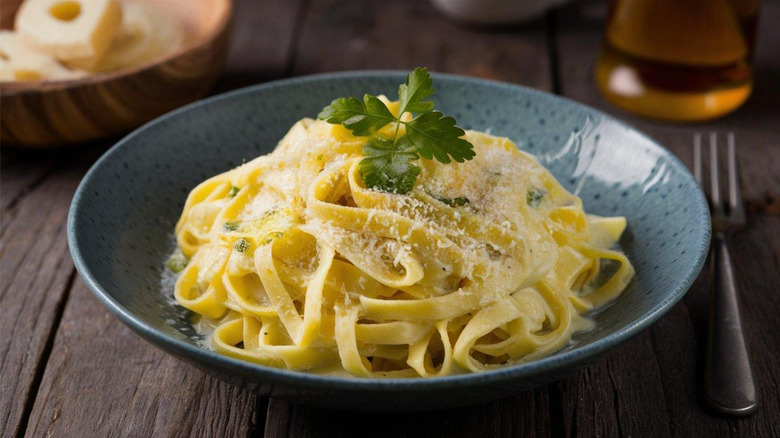Even with grocery store tips like reverse lists for easier shopping or photo hacks for smarter food buying, it’s too easy to forget an ingredient or two. This is when swaps can sometimes save the day, but you have to be careful about just what you can and cannot substitute. Rich, creamy, cheesy Alfredo sauce seems to have an obviously appropriate alternative should you neglect to pick up the heavy cream many recipes require: the half and half you keep in steady supply for your morning coffee. But we asked chef Jasper Mirabile Jr., cookbook author and owner of Jasper’s Italian Restaurant in Kansas City, Missouri, to be sure.
“If you only have half-and-half, that’s okay, because remember, the cheese is used as a thickening agent when you cook it down,” Mirabile tells Chowhound exclusively. “You may have to add a little bit more cheese, but believe me, this is what I teach in cooking class, and the sauce will thicken when reduced,” he says. So, it’s actually that other critical ingredient, the Parmigiano Reggiano, that you need to be more careful about keeping in stock. But Mirabile has an exchange for that, too, should you need one.
The Alfredo dairy you can switch in a pinch
If you’re out of real-deal Parmigiano Reggiano, don’t despair. Chef Mirabile doesn’t consider the prized imported cheese all that essential. “Actually, I love to use grated Romano cheese, pecorino,” he says. “Romano is really the best. You don’t have to use much salt at all, and it has a great flavor. But that’s because my family is from Sicily, and that’s what we’re used to using.”
When it comes to Pecorino Romano and Parmesan, the two have as many differences as they do commonalities. They are both hard cheese varieties sourced from Italy, but the latter is made from sheep’s milk, while Parm comes from cows. Pecorino Romano also has the saltier, more intense flavor Mirabile references versus Parm. That, and Pecorino Romano’s pronounced earthy quality might make you want to increase or reduce the amount a bit, depending on which you’re replacing and in what kind of preparation. There are also, of course, gradations between producers and further flavor development depending on how long either cheese has been aged. Because they appear and perform so similarly, you can trade them in a lot more cases than just Alfredo sauce, provided you calibrate the Pecorino Romano’s typically bolder notes. We’d also be happy to see either highlighted on a cheese board.






